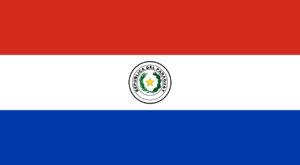History of Paraguay:
The indigenous people of Paraguay were fierce and warlike tribesmen. The first European explorer arrived in Paraguay in his 16th century. Spanish explorer Juan de Salazar he founded the city of Asuncion in 1537. Asuncion was to become the center of the Spanish colony.
In 1811, Paraguay expelled the local Spanish government and declared independence. For the next 80 years, three magnates ruled the country. First was Jose de Francia, then Carlos Lopez and finally Carlos’ son Francisco Lopez. In 1864, during the reign of Francisco Lopez, Paraguay fought Argentina, Uruguay and Brazil in the War of the Triple Alliance. Paraguay lost the war, losing two-thirds of its adult male population and much of its land.
The mid-20th century was a time of turmoil and civil war. Alfred Stroessner became dictator in 1954 and ruled for 35 years. During this time, Paraguay’s freedom was severely restricted. After his death, elections became relatively free.
Information about Paraguay:
| Capital | Asuncion |
| Population | 6,874,598 (Source: 2023 worldometer) |
| Major Cities | Asuncion (capital), Ciudad del Este, San Lorenzo, Luque |
| Borders | Bolivia to the northwest and north, Brazil to the northeast and east, and Argentina to the southeast, south, and west |
| Gross Domestic Product (GDP) | $41,722,295,362 (2022 worldometer) |
| Currency | guarani (PYG) |
Flag of Paraguay:
Paraguay Economy Key Industries:
Paraguay Major Industries: sugar, cement, textiles, beverages, wood products, steel, metallurgic, electric power
Paraguay Agricultural Products: cotton, sugarcane, soybeans, corn, wheat, tobacco, cassava (tapioca), fruits, vegetables; beef, pork, eggs, milk; timber
Paraguay Natural Resources: hydropower, timber, iron ore, manganese, limestone
Paraguay Major Exports: soybeans, feed, cotton, meat, edible oils, electricity, wood, leather
Paraguay Major Imports: road vehicles, consumer goods, tobacco, petroleum products, electrical machinery
The Geography of Paraguay:
Total Size of Paraguay: 406,752 km² (source: 2022 worlddata)
Geographical Low Point of Paraguay: junction of Rio Paraguay and Rio Parana 46 m
Geographical High Point of Paraguay: Cerro Pero (Cerro Tres Kandu) 842 m
Climate of Paraguay: subtropical to temperate; substantial rainfall in the eastern portions, becoming semiarid in the far west
General Terrain of Paraguay: grassy plains and wooded hills east of Rio Paraguay; Gran Chaco region west of Rio Paraguay mostly low, marshy plain near the river, and dry forest and thorny scrub elsewhere
World Region or Continent of Paraguay: South America
Geographical Coordinates: 23 00 S, 58 00 W
The People of Paraguay & Culture
Paraguay Government Type: constitutional republic
Paraguay Nationality: Paraguayan(s)
Paraguay National Holiday: Independence Day, 14 May 1811 (observed 15 May annually)
Paraguay Independence: 14 May 1811 (from Spain)
Paraguay National Symbol: lion
Paraguay National Anthem or Song: Paraguayos, Republica o muerte! (Paraguayans, The Republic or Death!)
Paraguay Languages Spoken: Spanish (official), Guarani (official)
Paraguay Religions: Roman Catholic 90%, Mennonite and other Protestant 10%
Interesting Facts about Paraguay:
Paraguay has a lot of wonderful wildlife such as porcupines, armadillos, chinchillas, tapirs, bears, jaguars and possums.
Paraguayans enjoy sports such as soccer, rugby, tennis and volleyball. Fishing is popular as well as soccer.
Paraguay is the only country in the world with a different coat of arms on the front and back of its flag. On the obverse is the national coat of arms and on the reverse is the seal of the Ministry of Finance with the motto “Paz y Justica” (Peace and Justice). Paraguay’s flag is one of the oldest national flags in the world.
Paraguay is a landlocked country with no maritime borders, but it has a well-trained navy. Its navy is the largest of any landlocked country in the world.
Endangered species include the jaguar, harpy eagle, red cockatoo, giant armadillo, and anteater (Jurumi). Other Uruguay animals include brown wolves, foxes, tapirs and over 1000 species of birds. Paraguay has many boas and crocodiles, as well as piranhas.
Paraguay’s colorful festivals also attract tourists. The San Juan Festival in June features firewalking among hot coals and embers, delicious food, and the ritual burning of the statue of Judas Iscariot. The San Blas Fiesta in February is a carnival celebration. Bus transport is safe and inexpensive. Paraguay is nicknamed “Corazón de America” (the heart of America). The name refers to Paraguay’s location in the center of the South American continent.
The name Paraguay comes from the Guarani language, which means water and palm crowns, and is said to mean “crowned river”. According to former president Juan Natalicio Gonzalez, it means “river of marine life”.
Flowing through Brazil, Paraguay and Argentina, the Paraná River is he second longest river in South America after the well-known Amazon River.
The Iguazu Falls on the Iguazu River consist of more than 275 waterfalls, which are taller than Niagara Falls and twice as wide as he.


